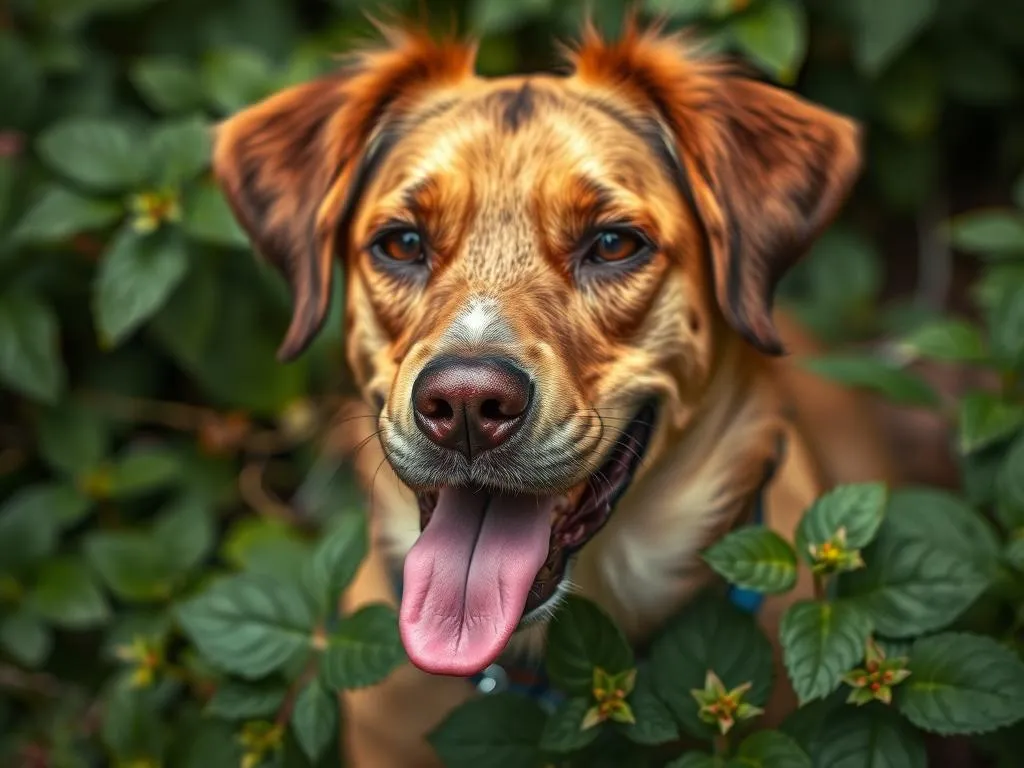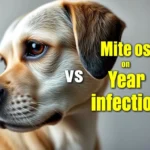
Introduction
Poison ivy is a plant that many pet owners may not think about until their dogs come into contact with it. This infamous plant contains urushiol oil, a potent allergen that can cause severe skin reactions in both humans and animals. Dogs, with their curious nature, are often at risk of encountering poison ivy during outdoor adventures, such as hikes or walks through wooded areas.
Understanding the implications of poison ivy on dogs is essential for any pet owner who enjoys outdoor activities with their furry companions. Many dogs love to explore parks, trails, and backyards, and this exposure increases the likelihood of coming across this hazardous plant. Recognizing the symptoms of poison ivy exposure and knowing how to take action can make a significant difference in your dog’s health and comfort.
Understanding Poison Ivy and Its Effects
What is Poison Ivy?
Poison ivy (Toxicodendron radicans) is a perennial plant that can appear as a vine, shrub, or small tree. It is easily recognizable by its distinctive three-leaf structure, which can vary in shape and size, making it sometimes difficult to identify. The leaves can range from glossy green to red in the fall.
Geographically, poison ivy is prevalent in various regions across North America, particularly in the eastern and central United States. It thrives in a range of environments, including forests, fields, and even urban areas. It’s important for pet owners to be aware of the plant’s habitats to minimize the risk of exposure for their dogs.
How Poison Ivy Affects Dogs
The culprit behind the reactions caused by poison ivy is urushiol oil, which is found in all parts of the plant, including the leaves, stems, and roots. When dogs come into contact with the plant, they can absorb this oil through their skin or by licking their fur after exposure.
Interestingly, dogs may not react to urushiol oil in the same way humans do. While many people develop an itchy rash upon contact, dogs may exhibit symptoms such as redness, swelling, and irritation. However, some dogs may be more sensitive to the oil than others, leading to varying degrees of reaction.
Symptoms of Poison Ivy Exposure in Dogs
Physical Symptoms
When a dog is exposed to poison ivy, several physical symptoms may manifest, including:
- Redness and Inflammation: The affected areas may appear red and swollen, indicating irritation.
- Itching and Scratching: Dogs often scratch or bite at the areas that feel itchy, leading to further irritation.
- Blisters and Rash Development: In more severe cases, blisters may form, which can be painful and uncomfortable for the dog.
Behavioral Symptoms
In addition to physical symptoms, dogs may exhibit behavioral changes that signal discomfort, such as:
- Increased Licking or Chewing of Affected Areas: Dogs may lick or chew at their paws or other areas that have come into contact with poison ivy.
- Restlessness or Discomfort: Dogs may seem agitated or unable to settle down, indicating they are uncomfortable.
- Avoidance of Certain Activities: If a dog usually enjoys going for walks or playing outside but suddenly avoids these activities, it may be a sign of irritation or pain.
Diagnosis and Veterinary Care
When to Consult a Veterinarian
If you suspect your dog has been exposed to poison ivy, it’s crucial to monitor their symptoms closely. Signs that warrant immediate veterinary attention include:
- Severe swelling or difficulty breathing.
- Large areas of blistering or rash.
- Signs of infection, such as pus or increased redness.
Discussing symptoms with a veterinary professional can help determine the best course of action. Even if symptoms seem mild, it’s always better to err on the side of caution.
Diagnostic Procedures
Veterinarians typically begin with a physical examination to assess the affected areas and evaluate the severity of the symptoms. In some cases, the vet may inquire about your dog’s exposure history, including where they were and what they may have come into contact with. There may also be a need for skin tests to rule out other causes of the symptoms.
Treatment Options for Poison Ivy Exposure
Home Remedies
If you suspect your dog has mild exposure to poison ivy, there are several home remedies that may provide relief:
- Cool Compresses: Applying a cool, damp cloth to the affected areas can help soothe the skin and reduce inflammation.
- Natural Anti-Itch Remedies: Oatmeal baths are a popular home remedy for soothing itchy skin. You can grind plain oatmeal into a fine powder and mix it with warm water for a soothing soak.
Veterinary Treatments
If the symptoms are more severe, your veterinarian may recommend:
- Prescription Medications: Antihistamines can help alleviate itching and reduce allergic reactions. Corticosteroids may also be prescribed for inflammation and swelling.
- Topical Treatments: Certain creams and ointments can help soothe the skin and promote healing.
Preventative Measures
Preventing exposure to poison ivy is the best approach. Some effective preventative measures include:
- Bathing Your Dog After Potential Exposure: If your dog is out in areas where poison ivy may grow, giving them a bath afterward can help remove any urushiol oil from their fur.
- Keeping Dogs Away from Known Poison Ivy Areas: Familiarize yourself with the appearance of poison ivy and avoid areas where it is prevalent.
How to Prevent Poison Ivy Exposure
Educating Pet Owners
Awareness is key in preventing poison ivy exposure. Pet owners should take the time to learn how to identify poison ivy in their environment. Understanding the risks during outdoor activities, such as hiking or playing in wooded areas, is also essential.
Training Your Dog
Training your dog to avoid specific areas can be beneficial. You can teach commands such as “leave it” to discourage them from approaching known poison ivy patches. Using a leash in high-risk zones can further prevent accidental exposure.
What to Do If Your Dog Gets Exposed
First Aid Steps
If you believe your dog has come into contact with poison ivy, take the following immediate actions:
- Remove the dog from the area to prevent further exposure.
- Wash Affected Areas: Use lukewarm water and mild soap to wash your dog’s skin and fur, focusing on the areas that may have come into contact with the plant. Be cautious not to spread the oil to other areas of the dog or yourself.
- Dry the Skin Gently: Use a clean towel to gently pat the skin dry after washing.
Monitoring Recovery
Keep a close watch on your dog’s symptoms. Monitor for any changes, such as increased itching or swelling. If symptoms worsen or do not improve within a few days, it’s crucial to follow up with your veterinarian.
Conclusion
Understanding the implications of poison ivy on dogs is vital for responsible pet ownership. By recognizing the symptoms of exposure, knowing when to seek veterinary care, and implementing preventive measures, pet owners can protect their dogs from the harmful effects of this plant.
Awareness and education are key components in keeping our pets safe. The bond between a pet owner and their dog is incredibly strong, and navigating challenges like poison ivy exposure can be an opportunity to strengthen that bond. We encourage pet owners to share their experiences and seek veterinary advice when needed.
FAQs
Can dogs be allergic to poison ivy like humans?
Yes, dogs can have allergic reactions to poison ivy, though the severity and type of reaction may differ from humans.
How long does it take for symptoms to appear?
Symptoms of poison ivy exposure in dogs can appear within hours to a few days after contact with the plant.
Is there a vaccine or permanent solution for poison ivy exposure in dogs?
Currently, there is no vaccine or permanent solution for poison ivy exposure in dogs. Prevention and prompt treatment of symptoms are the best strategies.









